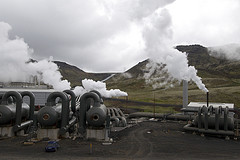- 1 read

We usually think of geothermal energy as a clean, renewable energy alternative to burning dirty fossil fuels. But new reports from the Inter Press Service reveal that geothermal plants in Iceland are creating environmental problems of their own, suggesting that the energy source may not be the best pollution solution.
When Iceland’s Hellisheidi geothermal plant began operation in 2006 there were immediately noticeable changes in the town of Reykjavik, which sits 18 miles downwind. Residents began having to clean their silverware every three to four days instead of every three to four months, as their possessions became covered in black soot. Truck drivers needed to have rubber in their steering and suspension systems replaced after one year instead of after five years, since the rubber hardened faster and became fragile. People suspected the plant of accelerating these processes, but nothing was ever looked into or publicized.
Years later, people began to notice the unusual decay of moss vegetation around the Hellisheidi plant. While geothermal plants emit steam that is 99.6 percent water, 0.4 percent of the vapor contains gases. 83 percent of the gas mixture is the greenhouse gas carbon dioxide (CO2), and 16 percent is hydrogen sulphide (H2S).
The Reykjavik Energy Company started to do tests on the patches of dead moss at Hellisheidi and two other Icelandic geothermal plants in order to determine what had caused the loss of moss. The tests showed that sulfur, derived from H2S, had poisoned the plants; more shocking, however, was that mercury was also found among the dead moss. Mercury and hydrogen sulphide in large doses are deadly, and Reykjavik has been exposed to them for years.
The Environment Ministry is now mandating a maximum permissible level of H2S emissions from geothermal plants, which should cut down the amount of contaminant exposure and environmental degradation, but the future for the energy source in general looks grim. The Hellisheidi plant is currently testing a project of pumping the H2S back into the system, but this has many uncertainties. Other various methods to reduce H2S emissions can be implemented, but these are very costly and still result in emissions of pure sulfur, sulfuric acid, and gypsum. Lastly, geothermal energy is not absolutely renewable, since it extracts more heat than is replaced. With your home-efficiency improvements, solar panels might be the better way to go.

